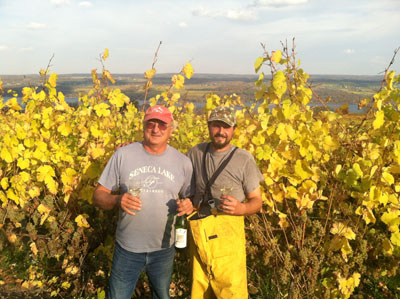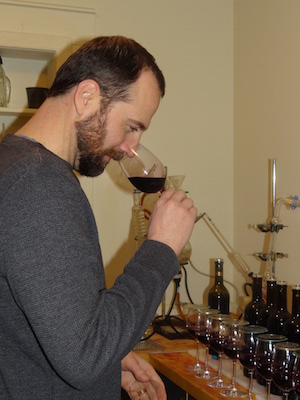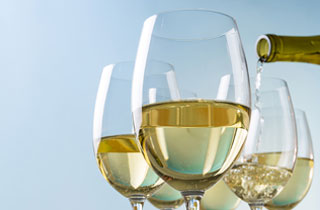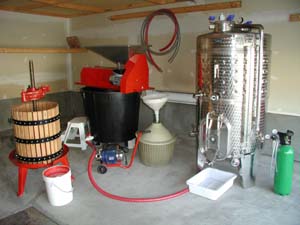Red wines from hybrid grapes can be frustrating — one day you have a deep garnet wine and the next you are wondering where the color went. Color stabilization is the key, and there are techniques to help.
 Winemaker: Alex Reynolds, Somerset Ridge Vineyard and Winery, Somerset, Kansas
Winemaker: Alex Reynolds, Somerset Ridge Vineyard and Winery, Somerset, Kansas
It is important to first consider the influence of climate on the production of phenolics with any cultivar, hybrid or vinifera. While colder climate grape growers often struggle with the delayed ripening, late frosts, and winterkill, one fortunate symptom of colder growing conditions stems from the inverse relationship between heat-accumulation and color. Grapes ripened over the course of fewer growing degree-days tend to retain more color than their warmer climate counterparts. As a result, colder climate viticulturists enter the conversation with a rare advantage over those in warmer regions.
With that in mind, the reputation that many red hybrid cultivars garner as producing wines with deficient or lighter color than many vinifera varietals is deserved, regardless of climatological factors. It’s common to hear of Frontenac or Marquette wines that start out with a deep, ruby color only to inexplicably fade to a burnt-Sherry orange after only a few months in the tank. As many hybrid grape growers are now aware, the primary cause of this deficiency is a lack of tannin in both the berries and finished wines.
The importance of tannin in bestowing structure, body and balance to red wines is already well established. However, fewer viticulturists are familiar with the vital role that tannin plays in polymerizing anthocyanins, the class of chemicals in red wine responsible for imparting color, and keeping them in solution throughout the winemaking process. The process of tannins polymerizing anthocyanins and other phenolic compounds in fermenting and finished wine is essential not only to stabilizing the color of the wine, but achieving it in the first place. Unfortunately, the un-polymerized, free-anthocyanin species, often most abundant in tannin-deficient hybrid based reds, are particularly prone to degradation from oxidation, sulfite bleaching, and hydrolysis – all inevitable outcomes of conventional winemaking. In their polymerized state, however, they are far more insulated from these degrading factors and are found in greater concentrations in the active “flavylium” form, responsible for the desirable, deep, crimson hues many winemakers seek from their reds. Accordingly, many of the red wines produced from the lighter tannin hybrids require extra work in both the vineyard and winery in order to produce a high quality product with rich, lasting color.
At Somerset Ridge, we produce a wide variety of wines derived from both hybrid and vinifera cultivars. From personal experience, the level of effort required to craft a stable, richly colored wine from our Frontenac, Marquette or Noiret grapes, is markedly greater than it is to produce one from our Cabernet Franc, Cabernet Sauvignon or Petit Verdot, in which there is generally abundant tannin. The phenolic profiles of the vast majority of vinifera cultivars are simply more conducive to producing wines with high concentrations of stable, polymerized anthocyanins, eliminating the need for subsequent blending or various tannin or concentrate additions.
Personal experience has shown that the most difficult cultivars to stabilize color in are the most tannin-deficient. Notably, Frontenac, Marquette, and St. Croix, all of which have averaged an exceptionally low 150-200 ppm tannin content from our vineyards in recent years. Conversely, the old-world hybrids, such as Chambourcin, Baco Noir, DeChaunac, and Marechal Foch, have tended to be more reliable in keeping their color. Noiret, perhaps the most tannic of the red hybrids, has also consistently produced a deep, inky wine that maintains its color over time.
The primary difference in managing the color of our hybrid-based red wines comes from the addition of grape-derived fermentation tannin. While we occasionally employ the use of tannin in our vinifera based wines, we utilize it for 100% of our red hybrid varietals to ensure maximum color stability. For the purpose of stabilizing color, it is important to use a tannin product that is derived primarily from grape skins as opposed to oak. While oak tannins do provide protection from oxidative degradation of anthocyanins, research indicates that they play little role in their actual polymerization. Accordingly, we utilize UVA’TAN, a grape skin-derived tannin from ScottLabs, for use in our hybrid red wines. There are two important considerations with the use of this and similar products when it comes to stabilizing color: the dosage and the timing of the addition. When working with red hybrids, specifically, the timing of the tannin addition to the wine is just as important as the dosage, if not more so. Recent research from Cornell University indicates that, unlike the majority of vinifera cultivars, grape solids from red hybrids retain significantly higher levels of tannin. The result being that what little tannin there is in the berry initially, remains largely bound to the cell walls of the grape skins, never making it into solution. To avert this problem, we add tannin only after pressing. This prevents solids from stealing the added tannin from the wine and saves a tremendous amount of time and money on the purchase and application of the product.
With regard to the dosage, research has shown that a 4:1 ratio of tannin to anthocyanin is optimal to achieving full color stabilization. Accordingly, we aim for this ratio when producing our red wines. However, bench trials are our foremost means of determining an appropriate dosage. Frequently, we end up administering 500-600 ppm of UVA’TAN, double the recommended dosage for red wines, in our Frontenac, Marquette and Chambourcin due to the inherently low levels of tannin in the grapes.
Managing pH is also of particular importance when dealing with hybrid wines. Though most hybrid reds already register sub 3.5 pHs on account of their naturally elevated acidities, it is important to maintain this lower pH due to the inverse relationship between pH value and anthocyanin expression. Color density and the proportion of anthocyanins in the flavylium state rapidly decline as pH rises. Subsequently, it is important to be aware of changes in pH for the purpose of enhancing color, particularly during malolactic fermentation as TA decreases during this period.
To be clear, color extraction is almost never the issue. Most red hybrids have extremely high (>2000mg/L) anthocyanin contents at crush. The problem is stabilizing these compounds during fermentation and aging.
Though adding enzyme at crush is now common practice, I do not recommend it for red hybrids when trying to maintain color. The same Cornell researched mentioned above indicates that adding enzyme, thereby increasing the ratio of grape solids to juice, only decreases the extractability of tannins in red hybrids, as they glom onto the grape solids and fall out of solution. This prevents them from polymerizing anthocyanins in solution, thereby decreasing color and its subsequent stability.
When it comes to color stabilization in wines made to age, oxidation has the most deleterious effect. If a wine lacks adequate SO2 to shield it from oxidation post-bottling or is otherwise exposed to oxygen during the aging process, the color, no less the integrity of the wine as a whole, will quickly diminish. Here again, tannin’s role not only as a stabilizer of color, but also as a natural antioxidant provides tremendous benefit to the age-worthiness of a wine. Since phenolic compounds break down over time, age-worthy, red, hybrid wines should be produced with sufficient levels of added tannin to withstand the diminishing effects of aging and to function as an oxidative shield for anthocyanin compounds over the life of the wine.
On occasion, no amount of tannin addition or pH manipulation will result in the desired color. Blending is far preferable to a concentrate addition, when possible.
 Winemaker: Sayre Fulkerson, Fulkerson Winery, Dundee, New York
Winemaker: Sayre Fulkerson, Fulkerson Winery, Dundee, New York
When it comes to the notion that hybrid grapes have trouble with color stabilization, sure, some hybrids are low in color like Rosette, but many are rich and darker than vinifera. In general it is about the varieties you are working with and skin contact and extraction. Rosette will never be dark no matter how it is fermented because of its low anthocyanin content. Vincent is several times higher in color than other varieties and color is never a problem. Other dark varieties are Baco Noir, Marechal Foch, and Frontenac. Hybrids typically have lower tannin than vinifera so some color is unstable and falls out during aging. Adding tannin or medium oak chips to the crushed grapes can help stabilize the color. A full fermentation on the skins can also help to extract as much color as possible. Another technique is adding enzymes such as Scottzyme® Color Pro. I would highly recommend following the enzyme manufacturer’s directions. The color released by enzymes will be stabilized by a tannin addition.
Varieties with a high pH tend to lose more color with age than wines with lower pH. High pH wines may not cellar well anyway but adjusting a low acid must before fermentation with tartaric acid will help bind and retain color.
The way you vinify the grapes will determine the color. Avoid over cropping and shaded canopies; by shoot positioning and summer pruning. Leaf pulling around clusters may help as well. A good rule is to have two clusters per shoot and 5–7 shoots per foot of row. Remove any non-fruiting shoots.
No matter what else you do, blending is sometimes the only answer. I look for a nice garnet red and try to avoid the blue spectrum in a finished wine, if I have a choice. Keeping a few bottles of a dark red variety such as Vincent wine could be handy when blending is warranted.
With all of that said, each variety has its own “normal” color, which I prefer to keep typical. I do not get too concerned with some color dropping out, as there is usually plenty of color left to be typical of that variety. A light fruity red would not be expected to be dark in color and therefore may not need color addition.
 Winemaker: Jeff Murphy, Johnson Estate Winery, Westfield, New York
Winemaker: Jeff Murphy, Johnson Estate Winery, Westfield, New York
If hybrid grapes are grown and produced with care they should result in similar or in some instances better color. If they are over-cropped and under-exposed to sun of course they are not going to have good color. That tends to be the biggest issue with hybrids and is the main reason they get looked down on. If you are growing hybrids you must expose the clusters to sun and keep them free from mildew. I have found the later ripening hybrids tend to have less, or less stable, color.
In the fermenter I will add more tannin or oak for hybrids because they do tend to be deficient in color-stabilizing tannin. Then give them a good dose of air during fermentation to stabilize the color. You need a bridge between the tannin or oak and the anthocyanin to stabilize. If it’s a wine that is being made to age, I follow a similar protocol but use mostly oak adjuncts (high-quality chips) from Stavin. Unfortunately, very few hybrids age that long: I have had good luck with Chancellor and Chambourcin though.
Hybrids and vinifera grapes both receive a similar enzyme protocol. When working with a grape that is deficient in color, an enzyme addition is a must. I use Trenolin Color from IDL Process Solutions, but there are many good suppliers. It also helps to get the must hot and then watch your sulfite levels as issues there can bleach your color.
Sometimes it is best to leave the wine alone. People tend to put too much emphasis on color: The question should be how does it taste? If it is dark but thin is it really any better?
 Winemaker: Alex Reynolds, Somerset Ridge Vineyard and Winery, Somerset, Kansas
Winemaker: Alex Reynolds, Somerset Ridge Vineyard and Winery, Somerset, Kansas

 Winemaker: Sayre Fulkerson, Fulkerson Winery, Dundee, New York
Winemaker: Sayre Fulkerson, Fulkerson Winery, Dundee, New York Winemaker: Jeff Murphy, Johnson Estate Winery, Westfield, New York
Winemaker: Jeff Murphy, Johnson Estate Winery, Westfield, New York




